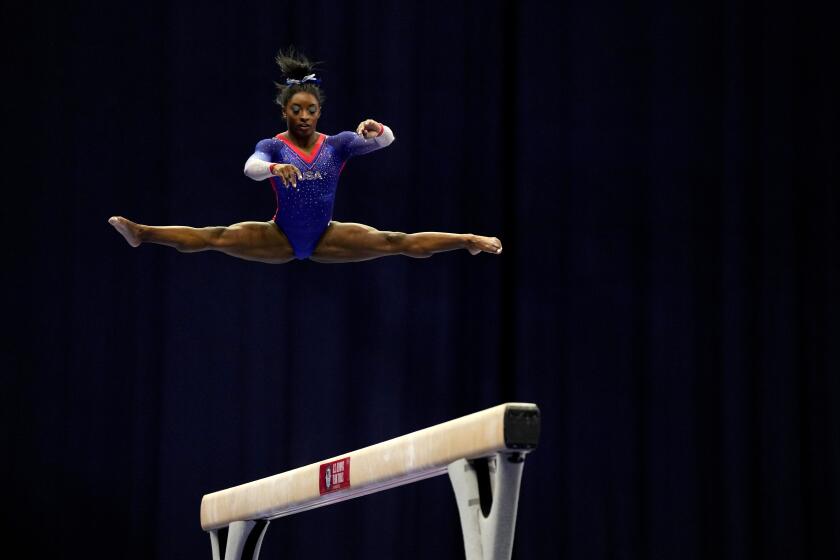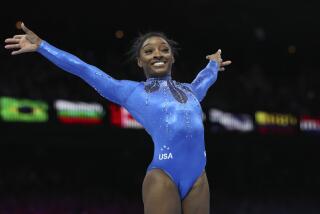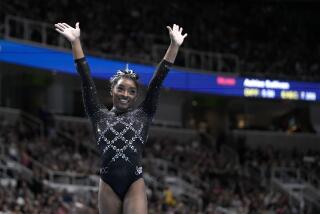Simone Biles, the greatest gymnast alive, could be the next marketing GOAT too

There’s a reason for the rhinestone goat outlined on Simone Biles’ leotard.
At 24, Biles has redefined what’s possible in gymnastics by performing complex skills few in the world can match. It’s why she’s acknowledged to be the Greatest of All Time (try abbreviating it).
When it comes to monetizing her abilities through sponsorships and other marketing deals, Biles may be just as special thanks to her unique combination of generational talent, leadership ability, social advocacy and knack for managing her own narrative.
It’s rare enough for an athlete to completely dominate her sport. Biles does so while presenting an authentic and relatable profile that extends far beyond the gym, making her one of the world’s most sought-after athlete-spokespersons.
“The sorts of personalities that come around are few and far between,” said Americus Reed II, professor of marketing at the Wharton School at the University of Pennsylvania. He compared Biles to Muhammad Ali — like the boxing great who transcended the ring to become an antiwar and civil rights icon, she is one of the few who can “take her brand with her” beyond gymnastics and into the “greater cultural stratosphere.”
Biles has captivated the gymnastics world since her first national all-around title in 2013. Since then, she has continually upped her game.
She is not only the first woman to attempt — and land — an extremely difficult vault in competition done only by a handful of men but also the namesake of four gymnastics skills. Any time a gymnast completes a double-twisting, double-backflip while dismounting from the balance beam, it’ll be known as the Biles.
Dramatic photos from Day 3 of the Tokyo Olympics, including scenes of Simone Biles and the USA men’s basketball team.
Brands like that, of course — after all, “people love people that win,” said Scott Tilton, co-founder and chief executive of sponsorship analytics and valuation platform Hookit. But attributing Biles’ marketing appeal to just her athletic accomplishments would be a mistake.
In an era when athletes are increasingly expected to display social responsibility, Biles has made a name for herself as a strong advocate for women and girls. She’s been an outspoken critic of how USA Gymnastics handled the conduct of longtime team physician Larry Nassar, who sexually abused hundreds of athletes and is serving a prison sentence of more than 100 years. Biles came forward in 2018 and said she too had been sexually abused by Nassar.
Recently, she encouraged fellow gymnast Jordan Chiles to train with her at her family’s gym in Texas, after Chiles was repeatedly passed over to represent the U.S. at international competitions despite good scores. Chiles is now one of the four-U.S. women competing to win a medal in the Olympic gymnastics team event.
“She’s not only just successful in gymnastics, but she also helps others thrive,” said Dae Hee Kwak, director of the University of Michigan’s center for sport marketing research. “This is much bigger than just winning another gold medal.”
Janey Miller, senior vice president of Olympics at Octagon, which represents Biles, said in an email that Biles has the “unique confidence” of an athlete regularly referred to as the greatest of all time while also maintaining a “disarming” level of humility and self-awareness.
“She does things with purpose, and she knows the importance of the role that she occupies in the minds of so many girls and women of all demographics,” Miller wrote. “She takes that role incredibly seriously.”
In April, Biles announced she would be leaving longtime sponsor Nike to sign with San Francisco-based Athleta, a much smaller brand owned by Gap Inc.
Gymnastics experts and those who have watched Simone Biles’ evolution explain how and why she became so much better than anyone else.
Biles said she admired Athleta’s focus on women’s empowerment and told the Wall Street Journal at the time that “they stand for everything that I stand for.” She was Athleta’s second high-profile, former Nike athlete — sprinter Allyson Felix previously joined Athleta after criticizing Nike’s policies related to maternity leave.
“Leaving Nike was a statement,” said Nicole Melton, associate department chair of the University of Massachusetts Amherst’s department of sport management. “That move showed that Nike has all the money in the world, but I want to be with a brand that represents my values. It’s just an amazing time we’re in now where athletes know their power and know they have a voice.”
Biles has been alert to the way certain tropes have historically been used to diminish accomplished female athletes — often by focusing on their physical appearance, relationships to famous men or rivalries with other women.
During the 2016 Olympics, she made headlines with an unapologetic rejection of comparisons to male athletes seemingly meant to flatter.
“I’m not the next Usain Bolt or Michael Phelps,” she said at the time. “I’m the first Simone Biles.”
By setting her own terms, Biles has kept her media coverage focused on her athletic success rather than the “generic approach,” said Ceyda Mumcu, associate professor of sports management at the University of New Haven.
“She was able to control those narratives,” Mumcu said. “Her success, the moves that are associated with Simone Biles’ name, her impact to gymnastics, all that came through more so than those other downplaying narratives that are usually used around women athletes.”
Biles has also been strategic about how she spends her brand capital.
Although she typically mentions fewer brands a year in her social media posts than former Olympians such as Bolt, the Jamaican sprinter, or U.S. gymnast Nastia Liukin, the ones she does post about are usually related to health and fitness, said Krishna Subramanian, chief executive and co-founder of Captiv8, an influencer marketing platform that collected and analyzed these data.
Her measured approach helps the strength of Biles’ brand, said Reed of the University of Pennsylvania.
“When we talk about creating meaningful partnerships with companies that she can truly believe in, she takes that seriously,” Miller wrote. “She is always thoughtful about what companies make sense as a partner for her, and which ones might not.”
Comparing Biles’ endorsement earning power to that of other Olympic champions is difficult. Financial terms of sponsorships are often not publicly disclosed, and agencies closely guard details about athletes’ true earnings.
But looking at generic brand deal terms can put a rough valuation on her social media presence.
An athlete could look to make $1 million to tens of millions of dollars for an endorsement consisting of commercials, print images and social media posts, said Ricky Ray Butler, chief executive of BEN Group, an influencer marketing company.
An Instagram post from a celebrity influencer with about 4.2 million followers, such as Biles, could cost a brand $100,000 to $200,000, according to estimates from BEN Group. A post from someone with 10.2 million followers, such as Bolt, could be valued at $150,000 to $250,000. A post from someone such as Phelps, the U.S. swimmer, with his 3.3 million followers, could cost $50,000 to $100,000. (Most companies, however, will look for longer-term endorsements with influencers than simply paying per post, according to BEN Group.)
A more tailored way to gauge earning potential is to look at sponsorship value metrics, which brands use to estimate the relative publicity value of working with a particular athlete or celebrity.
Comparing a selected group of standout Olympic athletes, Hookit found that Bolt had an estimated sponsorship value of $1.5 million, according to the company’s calculations. That figure was determined based on the number of Bolt’s followers, interactions across social media, rate of engagement and other factors.
Biles had an estimated sponsorship value of about $628,000. Phelps’ value was estimated at about $96,000, with Felix at about $75,000.
Of course, not all athletes are active on social media or do endorsements or ads there. And differences in career arc from athlete to athlete and sport to sport make apples-to-apples comparisons difficult. Both Phelps and Bolt have had careers spanning many more years than Biles, and those careers began before social media was widely used.
“It’s a little bit tough to make a direct comparison because obviously Phelps is finished, where Biles is still competing so it’s tough to tell where the trajectory of her career will go,” said Kris Mathis, founder of SponsorPitch, a platform that tracks sponsorship spending. “I think the upcoming Olympics will be a pivotal event for her.”
Compared with 2016, Biles’ marketability seems “very strong” and potentially “even greater,” said Kwak of the University of Michigan.
“With all the things that happened around our society in the past year,” he said, “I think there is a greater chance she will be more influential than just being a gymnast winning another gold medal.”









